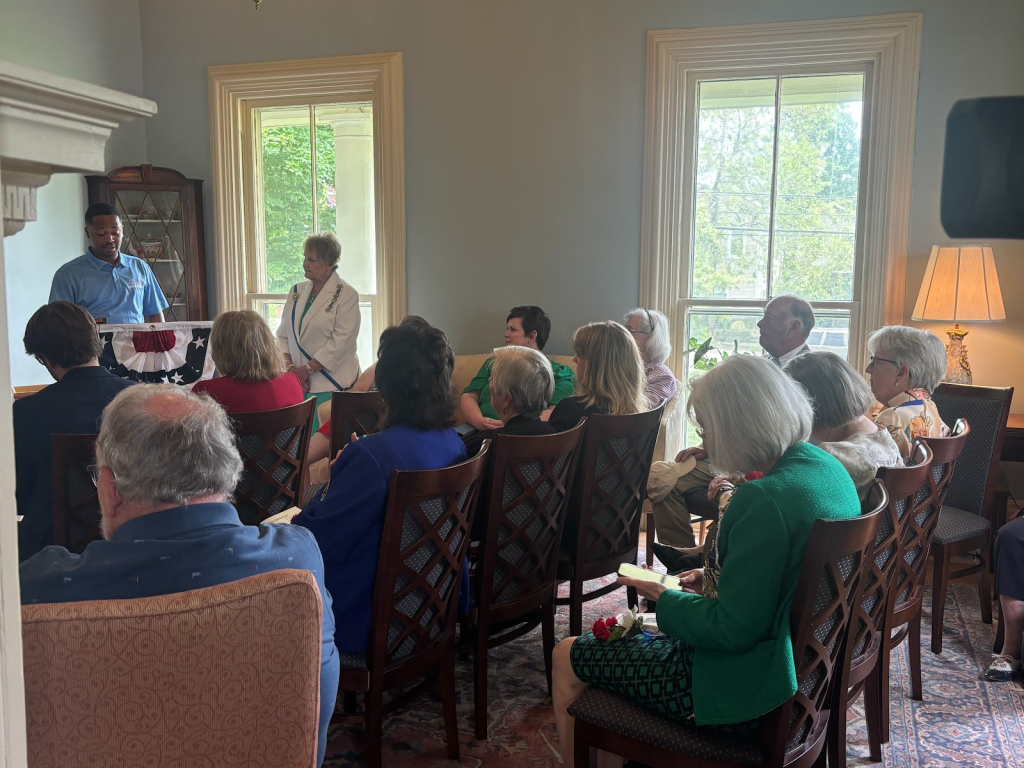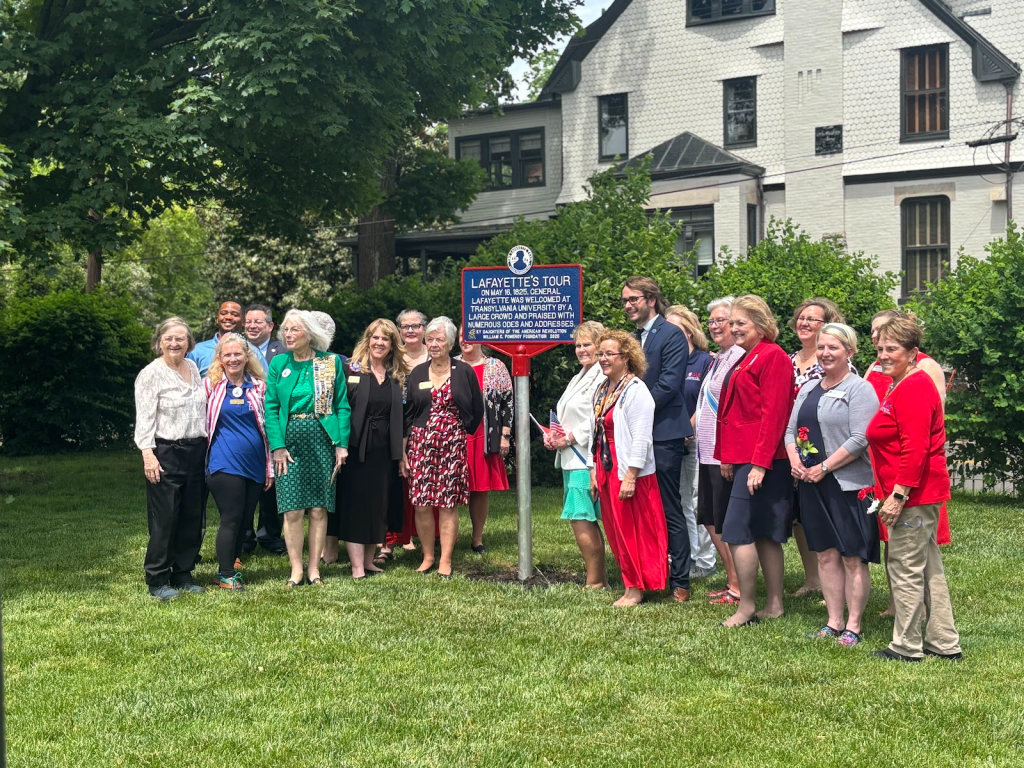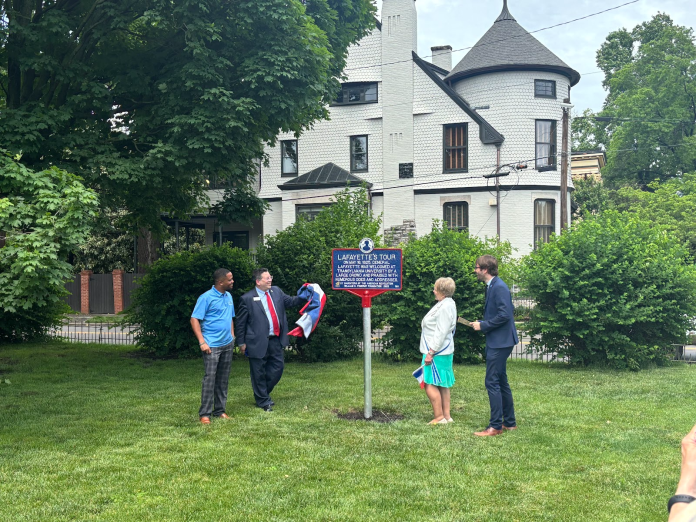On May 16th, 2025, members of the Transylvania administration, local leaders, and over a dozen members of the Lexington chapter of the Kentucky Society Daughters of the American Revolution (KSDAR) gathered together in a small room in Graham Cottage. All were there to witness the unveiling of a historic marker commemorating the 1825 visit of Marie-Joseph Paul Yves Roch Gilbert du Motier de La Fayette, better known as the Marquis de Lafayette, to Transylvania University. The marker came about due to a collaboration between the Lafayette Trail, a nonprofit organization tasked with commemorating and educating the public on Lafayette’s 1824-25 tour of the United States, and the KSDAR, a longstanding heritage organization comprised of women who can trace their lineage to the ‘patriots’ of the American Revolution. The marker was one of three dedicated in Lexington on the 16th, marking the bicentennial anniversary of Lafayette’s visit to Lexington on May 16th, 1825.
The Marquis de Lafayette, the namesake of Fayette County, was a young French aristocrat and officer who, in 1777, came to America to volunteer in the Continental Army under George Washington, where he was quickly commissioned as a major general. During the war, Lafayette was wounded at the 1777 Battle of Brandywine, was key to lobbying state officials for continued support during the nadir of Continental morale in 1780, and co-led the decisive charge on Redoubts 9 and 10 with Alexander Hamilton during the 1781 Siege of Yorktown, a blow to British defenses that led to the surrender of Lord Cornwallis’s British Army and the effective end of the Revolutionary War. After returning to France, Lafayette became a key figure in France’s own revolution, co-authoring the Declaration of Rights of Man and of the Citizen in 1789, a core document of the values of the early French Revolution. Lafayette was eventually targeted by Robespierre and the Jacobins and fled France in 1792, spent five years in an Austrian prison, had his citizenship partially restored by Napoleon Bonaparte in 1800, and was elected a member of the French Chamber of Deputies following the Bourbon Restoration in 1814.

In 1824, Lafayette, by that time the last surviving major general of the American Revolution, was invited by U.S. President James Monroe to tour the United States in anticipation of the nation’s upcoming semicentennial. Lafayette obliged and spent a little over a year touring all 24 states, being celebrated at every stop along the way. On May 16th, 1825, Lafayette arrived in Lexington, KY. After a military parade in his honor, Lafayette visited Transylvania University, at that time located in modern Gratz Park. Lafayette spoke to the gathered student body, and was similarly praised in a speech by University President Horace Holley, countless odes composed by students, and was awarded an honorary doctorate of law (the events and speeches of Lafayette’s visit to Lexington are recorded in Edgar Erskine Hume’s Lafayette in Kentucky, available in general circulation of the Transylvania University library).
The marker unveiled 200 years to the day of Lafayette’s visit to Transylvania contains a short summary of the visit and the adoration expressed by the campus. The text of the marker reads, “On May 16, 2025, General Lafayette was welcomed at Transylvania University by a large crowd and praised with numerous odes and addresses.” The marker was officially unveiled in front of Graham Cottage on the 16th by Transylvania President Brien Lewis, State Regent of the Kentucky DAR Linda Conrad, Lexington Councilmember Tyler Morton, and Lafayette Trail Founder and President Julian Icher.

Each of the unveilers spoke to the small crowd gathered in Graham Cottage on the importance of commemorating Lafayette’s visit. President Lewis emphasized Transylvania University’s historic significance and efforts to connect current Transy students to that history, citing renewed modern interest in Lafayette due to his depiction in the 2015 Broadway musical Hamilton and the excitement he sees when modern students learn the “Lancelot of the revolutionary set” visited the campus two centuries ago. Conrad explained how the Lafayette markers fit with the DAR’s three-pronged mission statement of promoting “historic preservation, education, and patriotism.” Conrad explained the DAR’s goals for the markers, stating, “These markers tell the history of Lafayette’s visit and they educate the public about the life of the last surviving general of the American Revolution…The information on each of these markers preserves the history of his visit, and hopefully inspires a patriotic pride in our country.” Morton described the marker as indicative of the values Lafayette fought for that continue to be important to this day, proclaiming Lafayette’s visit to be a “reminder of the enduring values of freedom, democracy, and solidarity between nations. Two-hundred years later, we still draw inspiration from his courage and his unwavering belief in liberty and justice for all.” Icher recalled the events of Lafayette’s visit to Transylvania for the gathered audience. Icher specifically focused on Horace Holley’s address, which categorized Lafayette as a “providential figure” and “moral man” whose visit was an endorsement of the continuing American experiment. The address also emphasized the importance of a liberal arts education in promoting republican principles.
The marker at Transylvania was one of three unveiled in Lexington on the 16th. A marker at the Ashland Estate commemorates Lafayette’s visit with the family of Henry Clay, and a marker at the Masonic Lodge on Harrodsburg Road commemorates the ball held for Lafayette at the Grand Lodge of Kentucky. Additionally, an interpretive sign noting Lafayette’s visit was installed in Gratz Park by the city of Lexington as part of the year-long 250Lex celebration commemorating the city’s semi-quincentennial.



